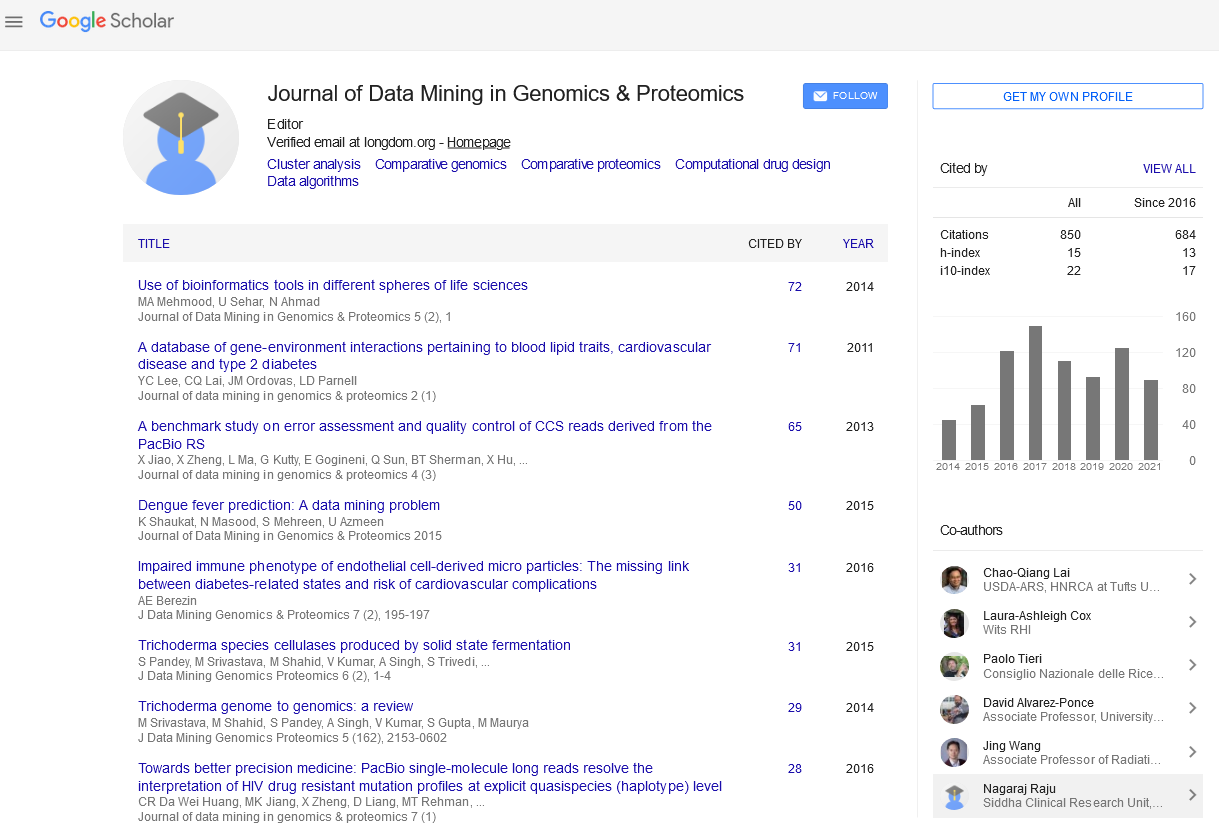PMC/PubMed Indexed Articles
Indexed In
- Academic Journals Database
- Open J Gate
- Genamics JournalSeek
- JournalTOCs
- ResearchBible
- Ulrich's Periodicals Directory
- Electronic Journals Library
- RefSeek
- Hamdard University
- EBSCO A-Z
- OCLC- WorldCat
- Scholarsteer
- SWB online catalog
- Virtual Library of Biology (vifabio)
- Publons
- MIAR
- Geneva Foundation for Medical Education and Research
- Euro Pub
- Google Scholar
Useful Links
Share This Page
Journal Flyer

Open Access Journals
- Agri and Aquaculture
- Biochemistry
- Bioinformatics & Systems Biology
- Business & Management
- Chemistry
- Clinical Sciences
- Engineering
- Food & Nutrition
- General Science
- Genetics & Molecular Biology
- Immunology & Microbiology
- Medical Sciences
- Neuroscience & Psychology
- Nursing & Health Care
- Pharmaceutical Sciences
Virtual screening of phytochemical constituents from traditional Indonesian herbs for inhibitors of aldose reductase
2nd International Conference on Big Data Analysis and Data Mining
November 30-December 01, 2015 San Antonio, USA
Sadaf Naeem1, Peter J Hylands2 and David J Barlow2
1University of Karachi, Pakistan 2King�??s College London, UK
Posters-Accepted Abstracts: J Data Mining In Genomics & Proteomics
Abstract:
Data on phytochemical constituents of herbs commonly used in traditional Indonesian medicine have been compiled as a database using ChemDBSoft software. This database (the Indonesian Herbal constituents�?? database, IHD) contains details on 1,242 compounds found in 33 different plants. For each entry, the IHD gives details of chemical structure, trivial and systematic name, CAS registry number, pharmacology (where known), toxicology (LD50), botanical species, the part(s) of the plant(s) where the compounds are found, typical dosage(s) and reference(s). A second database has been also been compiled for plant-derived compounds with known activity against the enzyme, aldose reductase (AR). This database (the aldose reductase inhibitors database, ARID) contains the same details as the IHD, and currently comprises information on 112 different AR inhibitors. In the search for novel leads active against AR to provide for new forms of symptomatic relief in diabetic patients, virtual screening of all compounds in the IHD has been performed using (a) random forest (RF) modelling, and (b) molecular docking. For the RF modelling, 3 sets of chemical descriptors �?? Constitutional, RDF and 3DMoRSE (computed using the DRAGON software) were employed to classify all compounds in the combined ARID and IHD databases as either active or inactive as AR inhibitors. The resulting RF models (which give misclassification rates of ~10%) were used to identify putative new AR inhibitors in the IHD, with such compounds being identified as those giving a mean RF score >0.5. Virtual screening of the IHD was also performed using the docking software, Molegro Virtual Dokcer (MVD). In the docking studies reported here, carboxyl-containing IHD compounds were docked in to the active site of the 11 crystal structures of AR bound to different carboxyl containing ligands. Calculation of the averages of these 11 MVD re-rank scores was carried out as a means to identify anomalous docking results. In vitro assays were subsequently performed to determine the inhibitory activity against human recombinant AR for four of the compounds obtained as hits in RF in silico screenings and for a further four compounds obtained as hits in the docking studies. All four of the RF and docking hits were (as predicted) active as AR inhibitors with IC50s in the micromolar range.
Biography :
Sadaf Naeem is currently working as an Assistant Professor at the Department of Biochemistry, University of Karachi. Completed PhD from King’s College London, UK in 2011 in the field of Computational Biophysics. Her research project has involved the construction of a computer database of the phytochemical constituents of herbs used in traditional Indonesian medicine, and the virtual screening and in vitro testing of these compounds in a search for aldose reductase inhibitors to provide new forms of symptomatic relief in diabetic patients. Her field of specialization is “Computer Aided Drug Design”, and taught at graduate and postgraduate level. She has supervised more than 10 Master’s thesis and also published more than 12 research articles in various scientific journals.
Email: sadafnaeem_4@yahoo.com


